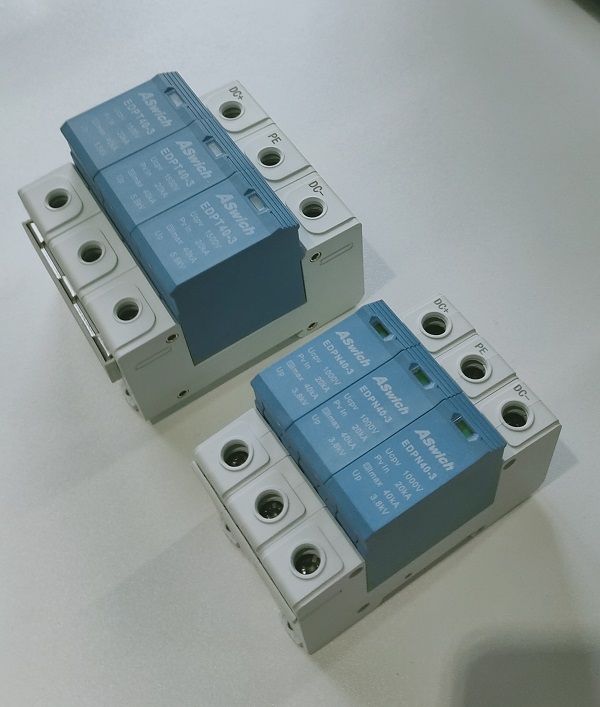A global leader in overvoltage protection devices, ASwich offers a comprehensive line of Surge Protective Devices (SPD) , components, and systems.Surge Protective Devices (SPD) are used to protect the electrical installation, which consists of the consumer unit, wiring and accessories, from electrical power surges known as transient overvoltages.
They are also used to protect sensitive electronic equipment connected to the installation, such as computers, televisions, washing machines and safety circuits, such as fire detection systems and emergency lighting. Equipment with sensitive electronic circuitry can be vulnerable to damage by transient overvoltages.

The effects of a surge can result in either instant failure or damage to the equipment only evident over a longer period of time. SPDs are usually installed within the consumer unit to protect the electrical installation but different types of SPD are available to protect the installation from other incoming services, such as telephone lines and cable TV. It is important to remember that protecting the electrical installation alone and not the other services could leave another route for transient voltages to enter the installation.
There are three different types of Surge Protective Devices:
Type 1 SPD installed at the origin, e.g. main distribution board.
Type 2 SPD installed at sub-distribution boards
(Combined Type 1 & 2 SPDs are available and are usually installed in consumer units).
Type 3 SPD installed close to the protected load. They must only be installed as a supplement to Type 2 SPD.
Where multiple devices are required to protect the installation, they must be coordinated to ensure correct operation. Items supplied by different manufacturers should be confirmed for compatibility, the installer and manufacturers of the devices are best placed to provide guidance on this.

What are transient overvoltages?
Transient overvoltages are defined as short duration surges of electricity which occur due to the sudden release of energy previously-stored or induced by other means. Transient overvoltages can be either naturally occurring or man-made.
How do transient overvoltages occur?
Man-made transients appear due to switching of motors and transformers, along with some types of lighting. Historically this has not been an issue within domestic installations but more recently, installations are changing with the advent of new technologies such as electric vehicle charging, air/ground source heat pumps and speed-controlled washing machines have made transients much more likely to occur within domestic installations.
Natural transient overvoltages occur due to indirect lightning strikes most likely to happen due to a direct lightning strike on an adjacent overhead power or telephone line causing the transient overvoltage to travel along the lines, which can cause significant damage to the electrical installation and associated equipment.
Do I have to have SPDs installed?
The current edition of the IET Wiring Regulations, BS 7671:2018, states that unless a risk assessment is carried out, protection against transient overvoltage shall be provided where the consequence caused by overvoltage could:
Result in serious injury to, or loss of, human life;
Result in interruption of public services and/or damage to cultural heritage;
Result in interruption of commercial or industrial activity;
Affect a large number of co-located individuals.
This regulation applies to all types of premises which include domestic, commercial and industrial.
In the previous edition of the IET Wiring Regulations, BS 7671:2008+A3:2015, there was an exception for some domestic dwellings to be excluded from surge protection requirements, for example, if supplied with an underground cable, but this has now been removed and it is now a requirement for all types of premises including single dwelling units. This applies to all new build and properties being rewired.
Whilst the IET Wiring Regulations are not retrospective, where work is being carried out on an existing circuit within an installation which has been designed and installed to a previous edition of the IET Wiring Regulations, it is necessary to ensure the modified circuit complies with the latest edition, this will only be beneficial if SPDs are installed to protect the whole installation.
The decision on whether to purchase SPDs is in the hands of the customer, but they should be provided with enough information to make an informed decision on whether they wish to omit SPDs. A decision should be made based on safety risk factors and following a cost evaluation of SPDs, which may cost as little as a few hundred pounds, against the cost of the electrical installation and equipment connected to it such as computers, TVs and necessary equipment, for example, smoke detection and boiler controls.
Surge protection could be installed in an existing consumer unit if appropriate physical space was available or, if enough space was not available, it could be installed in an external enclosure adjacent to the existing consumer unit.
It is also worth checking with your insurance company as some policies may state that equipment must be covered with an SPD or they will not payout in the event of a claim.

Aswich Surge Protective Device (SPD) is a no-fuse, fail-safe surge suppressor. UL 1449 4th Edition approved, it is DIN-rail mountable featuring a fail-safe self-protected design, visual indicator, small footprint, and a 50kA surge capacity.
Features
Explore the features of the Surge Protection Devices range:
Devices have indicators to advise end of life of the device
No resetting of SPD required, the excess voltage is quickly taken to earth, before the rest of the circuits are damaged
The device meets the requirements of the IEC 61634-1 and EN 61643-11 standards
The SPD enclosure can be fitted next to any exiting or new consumer unit of any brand where surge protection is required
